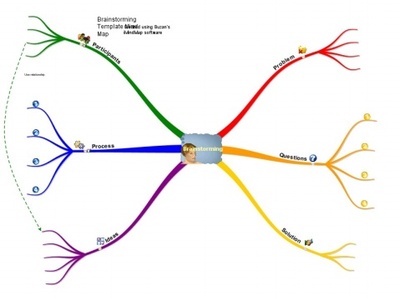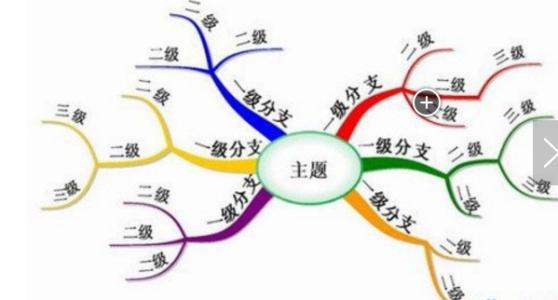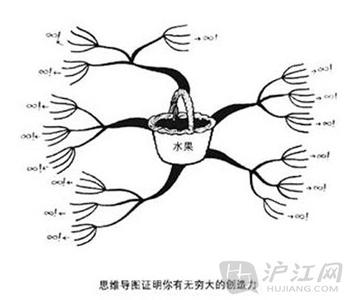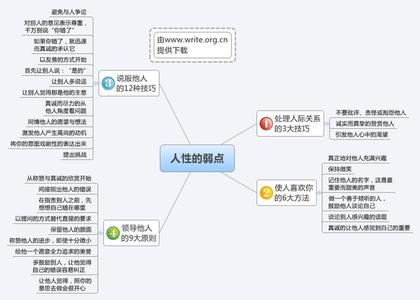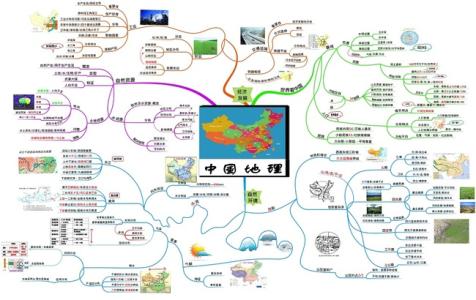最全的构词法用法详解<?xml:namespace prefix = o ns = "urn:schemas-microsoft-com:office:office" />
语言中词的总和构成词汇,但是词汇并不是一堆杂乱无章、互不相关的群体,而是一个严密体系,在这个结构的体系中,词与词之间有着各种各样的联系。英语中的这些联系的规律总结起来就是构词。英语中构词的方法就是构词法。构词法主要有合成法、转化法、派生法和缩略法四种。掌握构词法是迅速扩大词汇量的重要方法之一。
第一节 合成法
合成法就是指由两个或两个以上的单词合成的词叫合成词。这种构词方式主要有两种:复合法、结合法。合成法主要是构成合成名词和合成形容词。
复合法构成的复合词,它们各个结合的部分相互间的语法关系是紧密相关的。如blackboard和darkroom都是形容词和名词形成的结构,writing desk是动词名词和名词形式的结构。
结合法形成的词是形态合成词,它的结合是用一个起来连接作用的中缀来把两个或两上以上的词根词素紧紧的连缀在一起。如,用辅音字母-s-来缀全两个词根词素构成的词有:salesman, townspeople等。
合成的方式常见的有如下几种:
一、合成名词
1、名词/代词+名词:
woman-doctor, women-doctors, worhop, spaceship, he-goat, coal fire, motorcycle, gas cooker, oil well, power plant, silk worm, gold mine, bottleneck, piano keys, telephone receiver, television screen, chairman, fireman, motorman, police-officer, postman, pine tree, girl friend, boy friend, goldfish, raindrop, birdcage, breakfast time, flowerbed, tearoom,
2、动词+名词:blowpipe, flashlight, watchdog, call-girl, searchlight
3、形容词+名词:
blacmith, blackboard, supermarket, superman, darkroom, blackbird, highchair, hothouse, greenhouse, madman
4、动名词+名词:
reading-room, sitting-room, classroom, schoolroom, dining room, building materials, dancing girl, cleaning women, flying machine, washing machine, working conditions, boilding point, drinking water, swimming pool, drinking cup, typing paper, writing desk, sewing machine, walking stick,
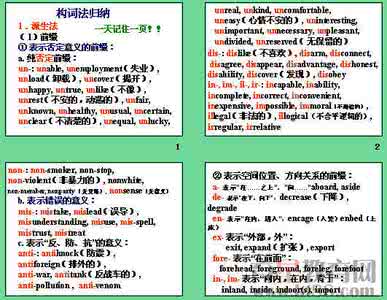
5、名词+动名词:
machine-building, shoe-making, paper-correcting, book-keeping, dressmaking, letter-writing, story-telling, town-planning, handwriting, sun-bathing, horse riding, churchgoing,
daydreaming
6、动词+副词:
stand-by, take-off, cut-off, breakdown
7、副词+名词:
downfall, rainfall, outhouse
8、现在分词+名词:
running dog, running water, flying fish, rising sun, burning stick,
9、名词+介词+名词:
man-of-war, editor-in-chief,
10、名词+连词字母+名词:
handiwork, nowadays
11、介词/副词+名词:
afternoon, inland, overbalance
二、合成形容词
1、形容词+名词+ed:
five-storeyed, one-eyed, double-faced, blue-eyed,
2、名词+名词+ed:
honey-mouthed,
3、名词/代词+分词:
man-made, heart-broken, self-educated, snow-covered, man-eating, peace-loving, paper-making, ocean-going, heartfelt, handmade, home-made, sunburnt, weather-beaten
4、名词/代词+形容词:
color-blind, ice-cool, seasick, airsick, tax-free, grass-green, snow-white, rock-hard, sea-green
5、形容词/数词+名词:
full-time, high-grade, second-hand,
6、形容词/数词+分词:
ready-made, sleepy-looking, good-looking,
7、副词+分词:
far-reaching, so-called, hard-working, far-reaching, well-meaning, newly-laid, well-meant, wide-spread
8、副词+形容词:
ever-green, under-ripe,
9、形容词+形容词:
dark-blue, red-hot, grey-green
10、介词+名词:
downhill, overnight
三、合成副词
1、形容词+名词:
sometimes, meanwhile
2、副词+名词:
oftentimes, indoors, outdoors, overhead
3、介词+名词:
alongside, beforehand
4、名词+形容词:
skyhigh, stonestill,
5、副词+介词:
nearby, upalong,
四、合成动词
1、 名词+动词:
overhear, underline
2、 形容词+动词:
moonwalk
3、 副词+动词:
white-wash, safeguard
五、其它合成词
1、合成代词:
everybody, everyone, everything, anyone, anybody, anything
2、合成介词:
outside, inside, throughout
第二节 转化法
不用借助构词词缀,把一个单词从一种词类转化成另一种词类的方法就是转化法。由于词类转化的结果,英语中就形成了大量外形相同但词类不同的词,即同形异类词。转化主要有如下几种类型。
一、名词起定语作用(类似名词转化为形容词):
space travel, television network, stone table, paper bag, water pipe, history teacher, college students
二、名词转化为动词:
boat?go boating, dust?to dust the desk, film?to film this story, mail?to mail, ship?to ship the goods, train?to train
三、形容词转化为动词:
slow?to slow down a little bit, dry?to dry your hands, wrong?to wrong sb, free?to free the slaves, narrow?to narrow the street,
四、动词转化为名词:
to act?an act, to dress?a good dress, to doubt?without any doubt, to guide us?a local guide, to smell?a terrible smell, to love?love of one’s country, to taste?a good taste, to demand?a demand for more equal rights
五、形容词转化为名词:
chemical?dangerous chemicals, daily?China Daily, final?a maths final, native?a native
第三节 派生法
派生法又叫词缀法,即在一个单词前或其后加上词缀,构成新的单词。中学英语中以派生法生成的词汇占整个中学词汇总量的25%。
一、前缀
一般说来前缀不会改变一个词的词性。
1、否定前缀
(1) un-
a. un +形容词:unfit, unhappy, unfair, unlucky, unfortunate, unkind, unimportant, unnecessary, uncomfortable, unselfish, unusual, uncommon, unexpected, unknown, unthinkable, unbelievable, unseen, unforgettable, unwise, unhealthy, unpleasant, unable, untrue
b. un+副词:undoubtedly, unexpectedly, unfortunately, unusually, unhappily, unluckily
由un+形容词构成的词除了unknown, unseen, unfit等词之外,其它词都可变为加-ly的副词(个别形容词尾需要变动)。
c. un+动词:uncover, untie, unlock, undress, undo, unpack
(2) im+形容词:impossible, impolite
(3) in+形容词:incorrect, incomplete, invisible, independent
(4) ir+形容词:irregular
(5) mis+动词:misspell, misunderstand, mistake
(6) dis-
a. dis+名词:dishonour, disease, discomfort
b. dis+形容词:dishonest, discouraged
c. dis+动词:disappear, dislike, discover, disclose, disagree, discomfort, dismiss
2、表示空间、位置关系的前缀
(1) a-,大多加在音节较少的名词或不及物动词上构成新词,表示“在……之上、向……、处于……状态”:ahead, abroad, aside, alive, awake, above, about等。
(2) fore-,表示“在……前面”:forehead, foreground, forearm, foreleg
(3) in, il, im, ir表示“向……内 在……内”:inside, include, import
(4) inter-,表示“在……间、相互”:international
(5) intro-,表示“在(向)……内”:introduce
(6) out-,表示“向外”:outside, outlook, outdoors, outflow
(7) over-,表示“在上面的、在外的”:overhead, overlook, overcoat, overcome, overtime, overgrow
(8) pre-,表示“在前”:prefix, preposition
(9) pro-,表示“在(向)前”:progress, programme
(10) sur-,表示“在……上”:surface, surround
(11) trans_,表示“转移”:translate
(12) under-,表示“在……下”:undergraound, underline
(13) up-,表示“向上”:upward, upset, upstairs
(14) be-,表示“在,靠近”:before, behind, below, between, beyond
(15)ex-,表示“向外,从……出来”:exchange, export
(16) tele-,表示“远”:telephone, television, telegram, telegraph
3、表示时间、序列关系的前缀
(1) fore-,表示“在前,预先”:foreword, foresight, foretell
(2) mid-,表示“中间”:midnight, midsummer, midautumn
(3) post-,表示“在……后”:postwar, postlistening
(4) re-,表示“重复”:review, retell, rewrite, replace, return, rebuild
(5) extra-,表示“格外、超越”:extraordinary
(6) over-,表示“超过”: overcome, overeat, overpass
(7) super-,表示“极、超”:supermarket, superpower, superman, superpower
4、表示共同、相等关系
(1) com-(在b, m, p前),col-,con-,cor-(com在g, l, r及其它辅音前):company, cnnect, correct
(2) co-:cooperate, coexist
(3) sym-:sympathy, symphony
5、表示整个、完全关系
(1) al-:alone, almost, altogether
(2) over-:overall, overflow, overfall
6、表示“离、离开”
(1) a-:arise, away, apart
(2) de-:depart, dewater, decolour
(3) se-:separate, select
(4) for-:forget, forgive
7、变换词类作用的前缀
(1) en-/em-:enable, enlarge, enrich, enclose, empower
(2) ad-,ac-,af-,ag-,an-,ap-,ar-,as-,at-,(ad-在c, f, g, I, n, p, r , s, t前的变体):adapt, across, affect, appear, arrange, assist, attend, attract
8、表示加强意义
(1) a-:ashamed, arouse, amuse
(2) ad-:address, admire, advise, advance
(3) be-:belong, believe
9、表示特殊意义
(1) arch-,表示“首位、主要”:architect
(2) auto-,表示“自动”:automobile, autobiography
(3) magni-,表示“大”:maginificent
(4) micro-,表示“微小”:microscope, Microsoft, microcomputer
(5) bi-,表示“数量”:biweekly, bicycle, bimonthly
(6) mini-,表示“小型”:minibus, miniskirt, mini-factory, mini-market
二、后缀
后缀是指在一个词的尾部加上一个词缀构成新的词。后缀往往会改变一个词的词性。常用后缀大约有96个,大致可分为五类。
1、名词后缀
(1) 构成表示人的名词后缀
a. 动词+er表示人:traveller, hunter, reader, worker, keeper, driver, listener, discoverer, reporter, owner, speaker, weaver, winner, buyer, leader, runner, swimmer, ruler, viewer
b. 名词+er表示人或物:villager, prisoner, geographer, farmer, lawyer, cooker
c. 形容词+er表示人:foreigner, stranger, southerner
d. 动词+or表示人:actor, director, inventor, operator, governor, professor, conductor, visitor, sailor
e. 名词+eer表示人:engineer, volunteer, mountaineer, pioneer
f. 名词(动词)+ress表示女性:actress, waitress, authouress, millionaires, tailoress, tigeress
g. 名词+cian:mathematician, physician, politician, musician
h. 名词+ese:Chinese, Japanese, Portugese, Taiwanese, Cantanese
i. 名词+an:American, Australian, Austrian, Canadian, Hungarian, Indian, Italian, Russian
j. 名词(或-al结尾的形容词)+ist:artist, communist, novelist, physicist, violinist, pianist, naturalist, socialist, scientist, typist
(2) 构成抽象名词与集合名词的后缀
a. 动词+age:package, marriage, carriage, postage, storage, luggage, baggage, percentage
b. 动词+ure:failure, pleasure, pressure, mixture, fixture
c. 形容词+ity:majority, electricity, activity, equality, possiblility, ablility
d. 动词+ment:argument, judgement, achievement, astonishement, development, excitement, encouragement, movement, government, punishment, treatment, statement, department, enrichment
e. 动词+ion/sion/ation/action/cation/ition:education, graduation, translation, separation, operation, celebration, congratulation, action, invention, attraction, connection, election, collection, devotion, pollution, decision, division, attention, description, production, redution, revision, permission, examination, explanation, consideration, invitation, imagination, pronunciation, satisfaction, addition, repetition, competition
f. 名词/形容词/动词+ery/ry:bravery, discovery, machinery, slavery, chemistry
g. 形容词/动词+y: difficulty, honesty, safety, activity, injury, unity, discovery
h. 动词+al:arrival, survival, burial, proposal, disapproval, refusal
i. 名词/形容词+ship:friendship, leadership, hardship, citizenship, comradeship, professorship, warship, memberhip
j. 名词+hood:boyhood, girlhood, childhood, neighbourhood, manhood
k. 动词+ance/ence:appearance, entrance, guidance, difference, reference
l.. 形容词/动词+th:truth, length, youth, strength, depth, wealth, warmth, width, growth
m. 形容词/名词+dom:wisdom, freedom, kingdom
n. 形容词/名词+ism:communism, socialism, Marxism, imperialism
o. 动词+ing:building, feeling, dancing, meeting
p. 形容词+ness:kindness, illness, sickness, brightness, selfness, correctness, happiness, darkness, weakness, carelessness
2、形容词后缀
(1) 名词/动词+able/ible:valuable, reasonable, comfortable, countable, enjoyable, horrible, terrible, responsible
(2) 名词+al/ia/ual:cultural, agricultural, natural, physical, musical, practical, national, technical, industrial, material, actual
(3) 名词+ic/ical:electric, basic, electric, atomic, plastic, magic, scientific, electrical, historical, medical, chemical, physical
(4) 名词+ish:foolish, childish, womanish, Spanish, British, English
(5) 名词/动词+ful:careful, powerful., tearful, beautiful, hopeful, wonderful, fearful, thankful, harmful, useful, frightful
(6) 名词/动词+less:careless, hopeless, useless, harmless, homeless, wireless, endless, selfless, powerless, fearless, valueless
(7) 名词+ar:regular, particular,
(8) 名词+ary:revolutionary, extraordinary, contrary
(9) 名词/形容词+ly:friendly, motherly, brotherly, monthly, weakly, wooly, lovely, lively, lonely
(10) 名词+en:wooden, woolen, golden,
(11) 名词+ern:eastern, western, northern, southern
(12) 名词+y:cloudly, sunny, shiny, windy, rainy, snowy, lucky, salty, hilly, funny, healthy, sleepy, foggy, dusty, lucky, muddy, wealthy, noisy, easy, dirty, thirsty, angry, hungry, smoky, sandy
(13) 名词+ous/ious:dangerous, famous, nervous, poisonous, serious, curious, various, mountainous, homourous
(14) 名词/动词+some:handsome, troublesome, tiresome
(15) 动词+ant:pleasant, excellent
(16) 动词+ive(atove):active, expensive, talkactive, comparative, relative
(17) 动词+ed:excited, learned, tired, interested, surprised, pleased
(18) 动词+ing:interesting, moving, exciting, tiring, surprising
3、副词后缀
(1) 形容词+ly:badly, nearly, mostly, quickly, roughtly, quietly, sliently, sadly, slowly, commonly, softly, frequently, rapidly, deeply, slightly, lightly, fairly, smartly, certainly, excitedly, curiously, firmly, sliently, constantly, seriously, particularly, coldly, suddenly, freely, highly, lately, finely, politely, completely, widely, immediately, unfortunately, surely, closely, truly, wholly, probably, simply, possibly, impossibly, getly, terribly, easily, busily, happily, heavily, angrily, prettily, hungrily, shyly, dryly, carefully, finally, usually, actually, really, naturally, beautifully, dully, fully, scientifically, phsically
(2) 名词/介词+ward/wards:northward, southward, eastward, westeward, downward, upward, backward, forward, toward, afterwards
4、动词后缀
(1) 形容词/名词+en:
deepen, broaden, widen, darken, weaken, sharpen, blacken, redden, whiten, tighten, stengthen, lengthen, heighten
(2) 形容词/名词+fy:beautify, satisfy, electrify, purify, terrify
(3) 名词/形容词+ ize/ise:realize, modernize
(4) -ate/由外来词构成:libreate, educate, operate, translate, graduate, separate, celebrate, congratulate
(5) -ish/由外来词构成:finish, publish, astonish
(6) 形容词+en:enable, enlarge, enrich
5、数词后缀
(1) 基数词+teen:thirteen, fourteenk fifteen, sixteen, seventeen, eighteen, nineteen
(2) 基数词+ty:twenty, thirty, forty, fifty
(3) 基数词+th:fourth, fifth, sixth, eighth, ninth
三、中缀
在英语有些词在结合时,需要有一个中间的起连接作用的中缀,这类词汇不多,常见的中缀是字母―s―。如:salesgirl, salesman, townspeople, townsman。
第四节 缩略法
缩略法是把原有的词汇通过缩短,在读音和写法一呈现新的形式,这种构词方式用得很普遍,特别是近几年来,随着科学技术的飞速发展,产生了很多新的缩略词。缩略法构词主要有如下几种。
一、剪切法(clipping)
剪切法的含义是从某个词的完整形式中删除一个或更多音节,这种方法构成的词汇往往认为是非正式的。
1、剪切原词的开始部分:omnibus---bus, bicycle---cycle, airplane/aeroplane---plane, taxicab---cab, telephone---phone
2、剪切原词的末尾部分:advertisment---ad, examination---exam, photograph--- photo, taxicab---taxi, laboratory---lab, public house---pub
(3) 剪切原词的中间部分:foot/feet---ft, half---hf, Greek---GK, yard---yd, year---yr, continued---contd
(4) 剪切原词的两端部分, 保留中间的部分字母:infludenza---flu, refiderator---fridge
二、混成法 (blending)
混成法是由两个词混合或紧缩而成为一个复合词的方法。这种复合词都保留了原来两个词的一部分,其后半表示主体,前半部分表示属性。
breakfast+luch? brunch smoke+fog? smog motor+hotel?motel boat+motor?botor news+broadcast?newscast television+braodcast?telecast
cheese+hamburger?cheeseburger beef+hamburger?beefburger
European+television?Eurovision
三、用首字母缩略(acronym)
大量的缩略语是其所含各个成分的第一个字母或多个字母构成的,由这种方式杨成的词叫做首字母缩略语 (acronym)。
(1) 按首字母拼读的缩略语:British Broadcasting Corporation---BBC, European Economic Community---EEC, United Nations---UN, Unidentified Flying Object---UFO, Very Important Person---VIP, Do-it-yourself---DIY, World Tread Organization---WTO
(2) 象单词一样拼读的首字母缩略语:North Atlantic Treaty Organization---NATO, the United Nations Educational, Scientific and Cultural Organization---UNESCO, lightwave amplification by stimulated emission of radiation---laser, acquired immunity deficiency syndrome---AIDS
<?xml:namespace prefix = v ns = "urn:schemas-microsoft-com:vml" />w.
 爱华网
爱华网